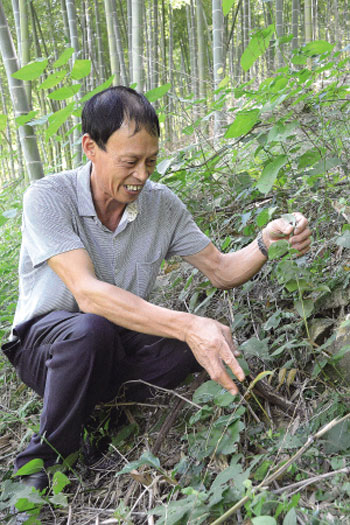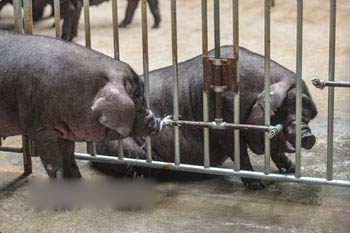It is the same as interplanting Polygonatum odoratum under Torreya grandis forest.

Yuan Yong shows Huang Jing.
Interplanting yellow essence under the Torreya grandis forest.
In the past two months, many Torreya grandis growers have come to learn from Wang Xiaojun in Shangliogang Village, Huangtan Town, Ninghai County. It turned out that he bought wild Polygonatum root interplanting in his own Torreya grandis base to innovate the economic model under the forest and became the first experimental base for Torreya grandis to interplant yellow essence in the city.
Huang Jing, also known as "longevity centenarian grass" in the folk. In the Tang Dynasty, du Fu had a poem saying, "sweep away the white hair and yellow essence, and you look at his ice and snow appearance." Rhizoma Polygonatum has high nutrition and health care value, and can be used in the development of related products such as food, health products and drugs. "now, the resources of wild Polygonatum polygonatum are gradually decreasing, the demand for medicine is increasing, and it has become a best-selling product. The artificial cultivation of Polygonatum polygonatum has just started, and the market prospect is quite broad. " Ninghai County Linte Terminal Senior engineer Wu Yufen said.
Longevity Centennial Grass settled in Torreya grandis Forest
Can Polygonatum polygonatum be cultivated artificially in the mountain forest to improve the comprehensive benefit of the woodland? In recent years, some forest farmers in Ninghai have tried to grow yellow and dig "gold" to develop the economy under the forest. Wang Xiaojun is one of them.
Wang Xiaojun began to grow Torreya grandis in 2009 and set up a Torreya grandis processing plant. Considering the practical problems such as long production time, slow output and difficult return of funds, he decided to use the land resources of Torreya grandis young forest to interplant Polygonatum chinensis.
"Polygonatum is both edible and medicinal, and has the characteristics of sustainable management. Last year, I began to interplant Rhizoma Polygonatum, but I didn't expect it to be a success. Now, my 100 mu of Torreya grandis fields have been interplanted with Polygonatum polygonatum as the main variety. In the future, tourists can come here to dig up Rhizoma Polygonatum and feel the fun of 'treasure hunting' in the forest! " Wang Xiaojun told me.
Wu Yufen said that Torreya grandis generally takes 8 to 10 years from cultivation to output, with high initial investment costs, high management costs and late returns, thus affecting the enthusiasm of farmers to develop Torreya grandis industry. Using Torreya grandis interplanting yellow essence can make full use of land resources and improve the land multiple cropping index, which can not only save the management cost, but also obtain early economic benefits and increase the income of Torreya grandis farmers.
It is reported that Ninghai County has a planting area of 12000 mu of Torreya grandis, of which more than 95% are young Torreya grandis forests. This year, a total of more than 100 mu of Torreya grandis forest has been interplanted in the county, which is expected to save more than 20% of management costs, increase the utilization rate of woodland by more than 50%, and increase the yield of Torreya grandis young forest by more than 30%.
There is a market for artificially cultivated Rhizoma Polygonatum
Another person who is optimistic about the market prospect of Polygonatum polygonatum is Yuan Yonghao, president of the Ninghai Dajia he Guangshun bamboo shoot professional cooperative. The Huang Jing cultivated by him and members of the cooperative began to harvest three years ago. Unlike Wang Xiaojun, Yuan Yong's Huang Jing "lives" in the bamboo forest.
Yuan Yonghao said that Rhizoma Polygonatum needs a moist and shady environment to grow. There are lots of bamboo forests in the village where the cooperative is located. The bamboo forests are tall and dense, while the underneath is relatively cool and humid, which is suitable for the growth of Huang Jing. In the past, the villagers could dig up a lot of wild Polygonatum in the mountains and forests, but the number has become less and less in recent years. "since there is an environment suitable for the growth of Polygonatum polygonatum, why don't we try artificial cultivation?"
In 2013, Yuan Yong began to cultivate Polygonatum in 200 mu of bamboo forest. After years of cultivation, 1500 kilograms of fresh yellow essence have been produced in the bamboo forest this year. He told me that Rhizoma Polygonatum is all wild in the mountains. The large rhizomes are processed directly, and the small ones are raised and then transferred to the bamboo forest, which is the so-called imitation wild planting under the forest. "Polygonatum polygonatum can be produced after 3 to 4 years of planting. This year, we have processed 250 kilograms of Huangjing tea, which can be sold for 800 yuan a kilogram on the market, with obvious output benefits. "
The relevant person in charge of Ninghai County Agriculture and Forestry Bureau said that interplanting Polygonatum polygonatum in bamboo forest is a management model of the economy under the forest, which can make full use of land resources, increase the land multiple cropping index, and enhance the economic benefits of forest farmers. The use of bamboo ploughing to plant Polygonatum, through the management of Huangjing to manage the bamboo forest, not only save labor, but also "drum" the purse of forest farmers.
Related
- A course of planting techniques and methods on how to grow carrots
- How to plant the latest tulips?
- Is it better to pick tea in the morning or in the afternoon? When is the best time for tea to be picked? what is the third or fifth tea?
- Launch Yuanxiao Happy combination Haocha + Tea Yuan healthy Taste
- Penghu Tourism "Fireworks 20 Parade with You"
- 2022 West Lake Happiness holds "Digital Revitalization Voucher" and draws iphone13 and laptop.
- Banqiao Fuzhou social houses are designed to change start-up combined with police elimination to create a safe and livable environment
- The convenient measure of "mechanical weeding" in Xinbei has been abused and the Agriculture Bureau has imposed heavy penalties on the illegal land consolidation.
- Changgeng University Joins Hands with Four Memory Factories to Rescue Memory Talent Shortage
- The list of Taiwan's top 100 MVP managers is listed by the Director-General of the Farmers' Association of Sanxia District.



